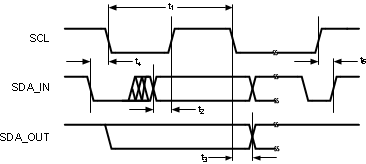SNOSCS2D November 2013 – March 2019 LM3697
PRODUCTION DATA.
- 1 Features
- 2 Applications
- 3 Description
- 4 Revision History
- 5 Pin Configuration and Functions
- 6 Specifications
-
7 Detailed Description
- 7.1 Overview
- 7.2 Functional Block Diagram
- 7.3 Feature Descriptions
- 7.4 Device Functional Modes
- 7.5 Register Maps
- 8 Application and Implementation
- 9 Power Supply Recommendations
- 10Layout
- 11Device and Documentation Support
- 12Mechanical, Packaging, and Orderable Information
Package Options
Refer to the PDF data sheet for device specific package drawings
Mechanical Data (Package|Pins)
- YFQ|12
Thermal pad, mechanical data (Package|Pins)
Orderable Information
6.6 Timing Requirements
| MIN | NOM | MAX | UNIT | |||
|---|---|---|---|---|---|---|
| I2C-COMPATIBLE TIMING SPECIFICATIONS (SCL, SDA)(1) | ||||||
| t1 | SCL (clock period) | 2.7 V ≤ VIN ≤ 5.5 V | 2.5 | µs | ||
| t2 | Data In set-up time to SCL high | 2.7 V ≤ VIN ≤ 5.5 V | 100 | ns | ||
| t3 | Data out stable after SCL low | 2.7 V ≤ VIN ≤ 5.5 V | 0 | ns | ||
| t4 | SDA low set-up time to SCL low (start) | 2.7 V ≤ VIN ≤ 5.5 V | 100 | ns | ||
| t5 | SDA high hold time after SCL high (stop) | 2.7 V ≤ VIN ≤ 5.5 V | 100 | ns | ||
| INTERNAL POR THRESHOLD AND HWEN TIMING SPECIFICATION | ||||||
| VPOR | POR reset release voltage threshold | VIN ramp time = 100 µs | 1.7 | 2.1 | V | |
| VIN ramp time = 100 µs, TA = 25°C | 1.9 | |||||
| tHWEN | First I2C start pulse after HWEN high | 2.7 V ≤ VIN ≤ 5.5 V, POR reset complete | 20 | µs | ||
| POR reset complete, TA = 25°C | 5.0 | |||||
 Figure 1. I2C-Compatible Interface Timing
Figure 1. I2C-Compatible Interface Timing